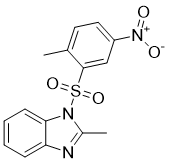| Cas No.: | 93987-29-2 |
| Chemical Name: | BI-6015 |
| Synonyms: | BI 6015;2-Methyl-1-(2-methyl-5-nitrophenylsulfonyl)-1H-benzo[d]imidazole;2-Methyl-1-[(2-methyl-5-nitrophenyl)sulfonyl]-1H-benzimidazole (ACI);Benzimidazole, 2-methyl-1-[(5-nitro-o-tolyl)sulfonyl]- (7CI);2-Methyl-1-(2-methyl-5-nitrobenzenesulfonyl)-1H-1,3-benzodiazole;2-Methyl-1-(2-methyl-5-nitrophenyl)sulfonylbenzimidazole;BI-6015 |
| SMILES: | [O-][N+](C1C=C(S(N2C(C)=NC3C2=CC=CC=3)(=O)=O)C(C)=CC=1)=O |
| Formula: | C15H13N3O4S |
| M.Wt: | 331.346421957016 |
| Purity: | >98% |
| Sotrage: | 2 years -20°C Powder, 2 weeks 4°C in DMSO, 6 months -80°C in DMSO |
| Publication: | [1]. Kiselyuk A, et, al. HNF4α antagonists discovered by a high-throughput screen for modulators of the human insulin promoter. Chem Biol. 2012 Jul 27;19(7):806-18. |
| Description: | BI-6015 is a hepatocyte nuclear factor 4α (HNF4α) antagonist that can inhibit the expression of known HNF4α target genes. BI6015 represses insulin promoter activity through HNF4α antagonism. BI-6015 can be used for the research of cancer and diabetes[1]. |
| In Vivo: | BI-6015 (10-30 mg/kg; i.p. once daily for 5 days) induces loss of HNF4α expression and hepatic steatosis in mice[1]. BI-6015 (10-30 mg/kg; i.p. daily or every other day for 20-57 days) induces apoptosis in a human hepatocellular carcinoma mouse model[1]. |
| In Vitro: | BI-6015 (1.25-20 μM; 24-72 h) is cytotoxic to human hepatocellular carcinoma (HCC)[1]. BI-6015 (2.5-10 μM; 5-48 h) inhibits HNF4α gene expression in HepG2 cells[1]. BI-6015 (5 μM; 3 d) induces hepatic steatosis in primary murine hepatocytes[1]. Cell Viability Assay[1] Cell Line: Hep3B-Luc cells and primary hepatocytes Concentration: 1.25, 2.5, 5, 10, 20 μM Incubation Time: 24, 48, 72 hours Result: Was markedly toxic to Hep3B cells but spared primary hepatocytes. |
| References: | [1]. Kiselyuk A, et, al. HNF4α antagonists discovered by a high-throughput screen for modulators of the human insulin promoter. Chem Biol. 2012 Jul 27;19(7):806-18. |

 To enhance service speed and avoid tariff delays, we've opened a US warehouse. All US orders ship directly from our US facility.
To enhance service speed and avoid tariff delays, we've opened a US warehouse. All US orders ship directly from our US facility.




















